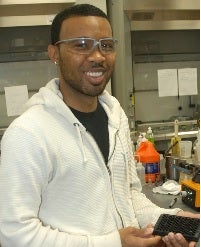Identifying illegal drugs rapidly, accurately and safely in the field is a challenge for law enforcement and forensic analysts, and often false positives come up with the technology available to them.
A University of Central Florida graduate student may be ready to give investigators the tool they need through a hand-held device he is developing. David Nash, a Ph.D. student in chemistry just landed the university’s first National Institute of Justice Graduate Research Fellowship in Science, Technology, Engineering and Mathematics award of $50,000 to continue work on a prototype.
The NIJ is the research-funding branch of the Department of Justice. Annually, it provides a monetary award to a handful of graduate students to conduct research in the social or physical science fields that will help the criminal justice, law enforcement, or forensic communities.
Nash and his advisor, physics professor Richard Blair, developed the tool, which uses chemically coated strips and a palm-sized spectrometer device equipped with an ultraviolet light to test substances.
With the help of UCF’s I-Corps program, which pairs selected UCF students and faculty teams with industry mentors and funding to develop new technologies, Nash and Blair have formed a company – called IDem – to manufacture the devices and take them to market.
Like many discoveries, Nash said the idea behind the device came serendipitously when his work for NASA’s Jet Propulsion Laboratory overlapped with a project for the Orange County Sheriff’s Deparatment in California.
Because almost all pharmacologically active substances contain nitrogen, Nash said he and Blair began experimenting with methods for interacting with that element to distinguish between different drug formulations.
The winning formula came when they mixed copper iodide from the propulsion-laboratory project with nitrogen and created a new compound that lights up or fluoresces when exposed to ultraviolet light. Depending on the identity of the drug that is tested, the light turns a different color.
Nash said the test is far more accurate and safer than chemical spot tests, which can destroy the evidence and require field officers to use potentially hazardous reagents. Existing tests have not only resulted in burns for the users, they have been known to mistakenly identify harmless substances such as sugar, soap and tea leaves as contraband.
The new method may also reduce the backlog in crime labs where seized substances can sometimes sit for months awaiting confirmation testing while the owners remain falsely imprisoned, Nash said.
The team has engaged law enforcement agencies including the UCF Police Department, Seminole County Sheriff’s Office, Sarasota County Sheriff’s Office, as well as other law enforcement agencies around the country to test the devices.
The next step is to implement a smartphone app that will access a cloud-based database of known drug controlled substances and compare the test results to provide an even more accurate verification than is possible with the human eye.
Nash said he expects a beta version of the device to be available early next year. He has some advice for students thinking about taking on a “tough” science degree.
“I put in a lot of work to get to where I am today… so for anyone who thinks that they don’t belong in college, a certain tough degree program, or those that doubt their own intelligence because they don’t have a 4.0 GPA, hard work really does pay off and it’s really the effort you put in that will determine whether you belong or not,” he said.
